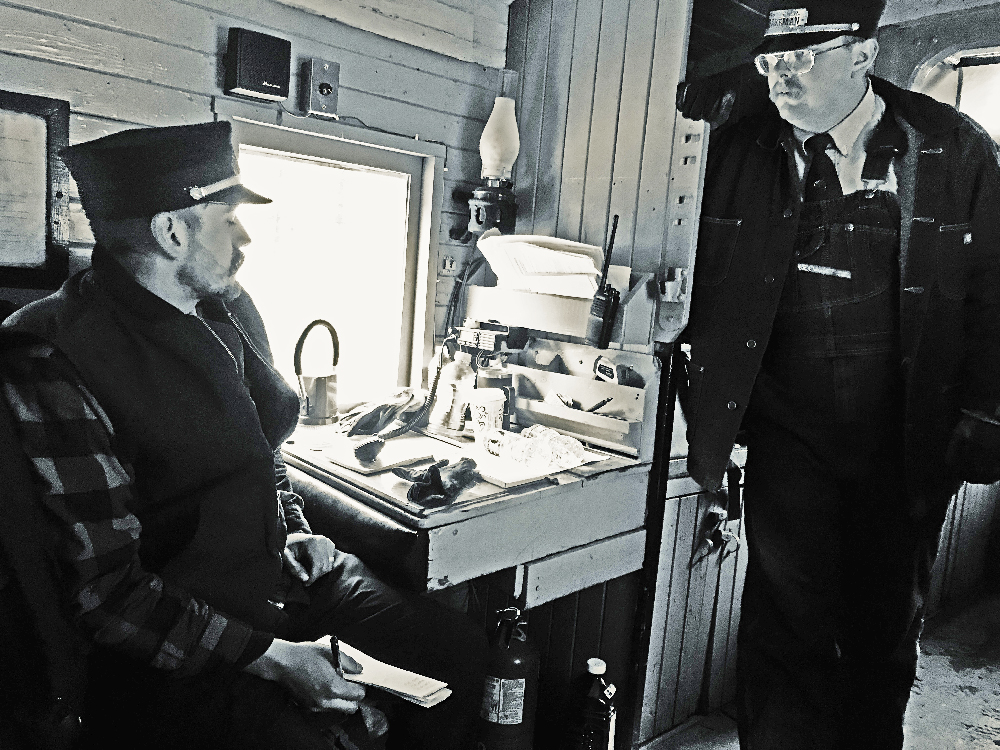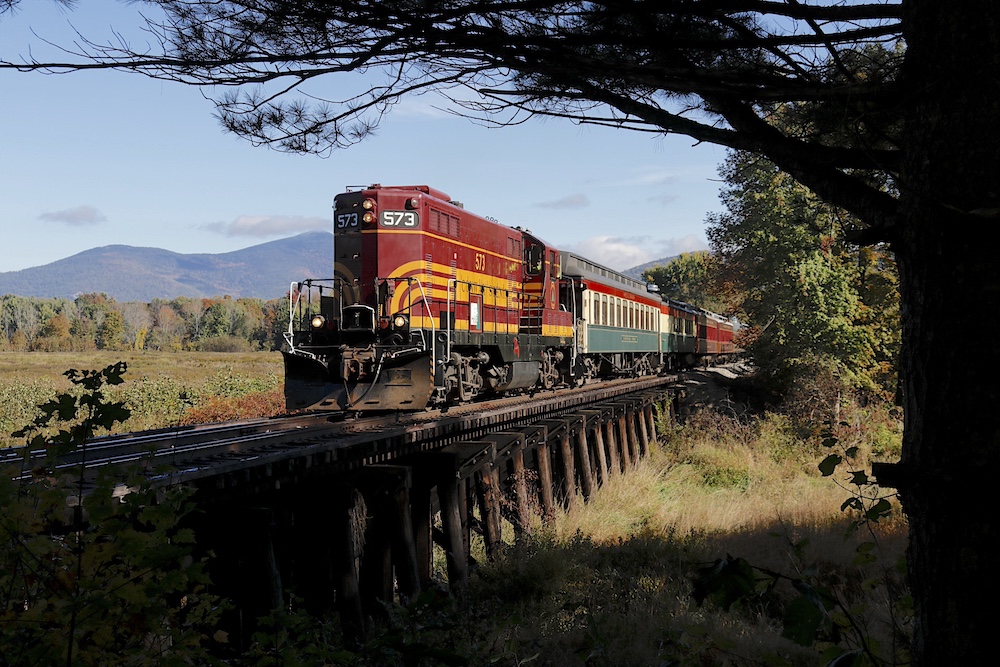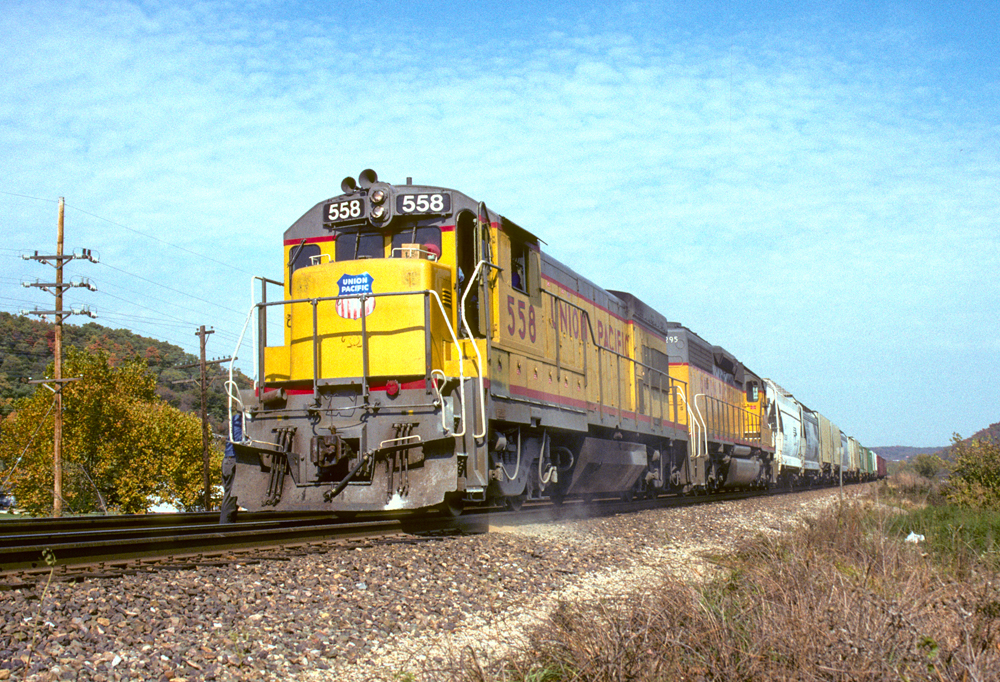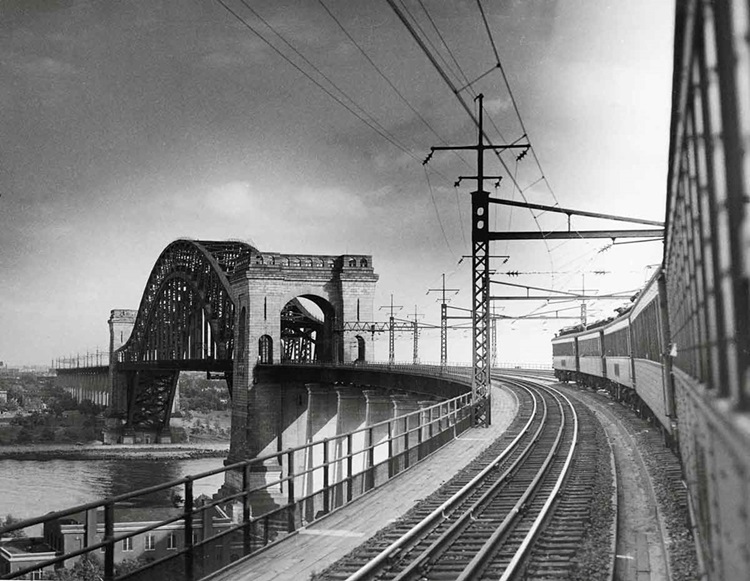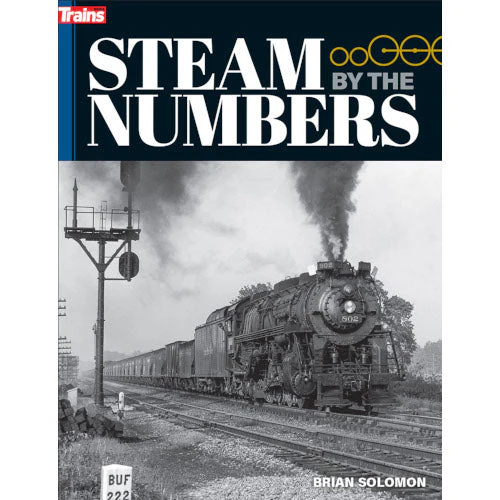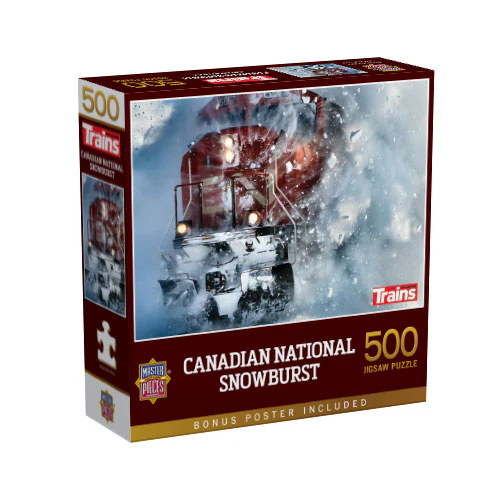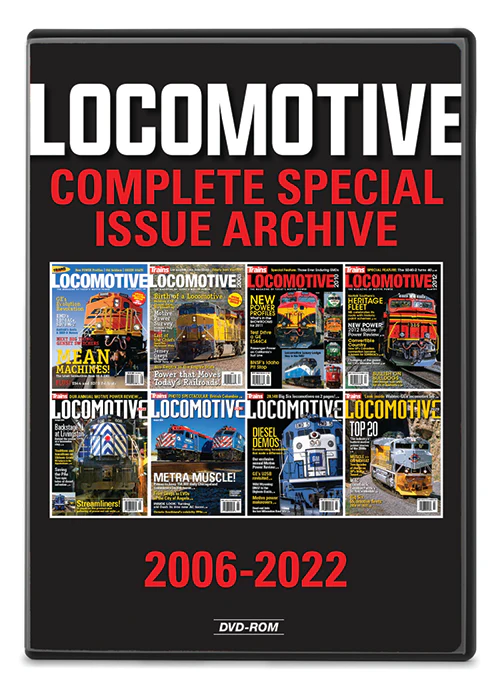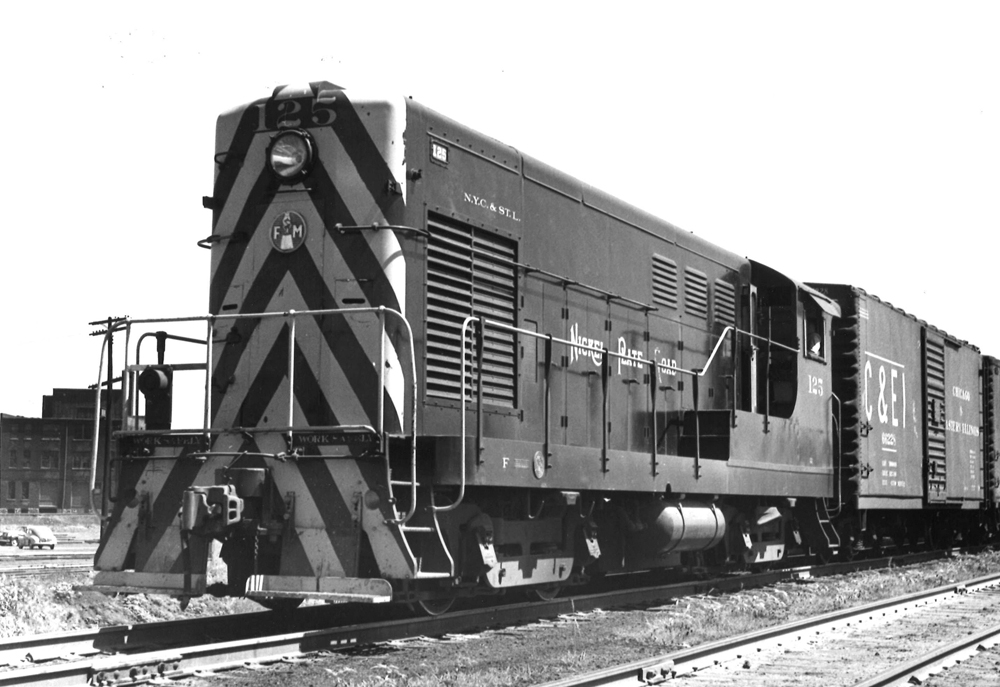
Fairbanks-Morse switcher
Nickel Plate Road No. 125 was one of 9 Fairbanks-Morse 1,000-horsepower H10-44 switchers the road received in 1949. NKP also got 22 H12-44s in 1953–58. A longtime supplier of railroad equipment, Beloit, Wisconsin-based F-M built diesel locomotives for U.S. service between 1944 and 1958 before closing out production with a Mexican order in 1963.
Louis A. Marre collection
Nickel Plate Road No. 125 was one of 9 Fairbanks-Morse 1,000-horsepower H10-44 switchers the road received in 1949. NKP also got 22 H12-44s in 1953–58. A longtime supplier of railroad equipment, Beloit, Wisconsin-based F-M built diesel locomotives for U.S. service between 1944 and 1958 before closing out production with a Mexican order in 1963.
Louis A. Marre collection

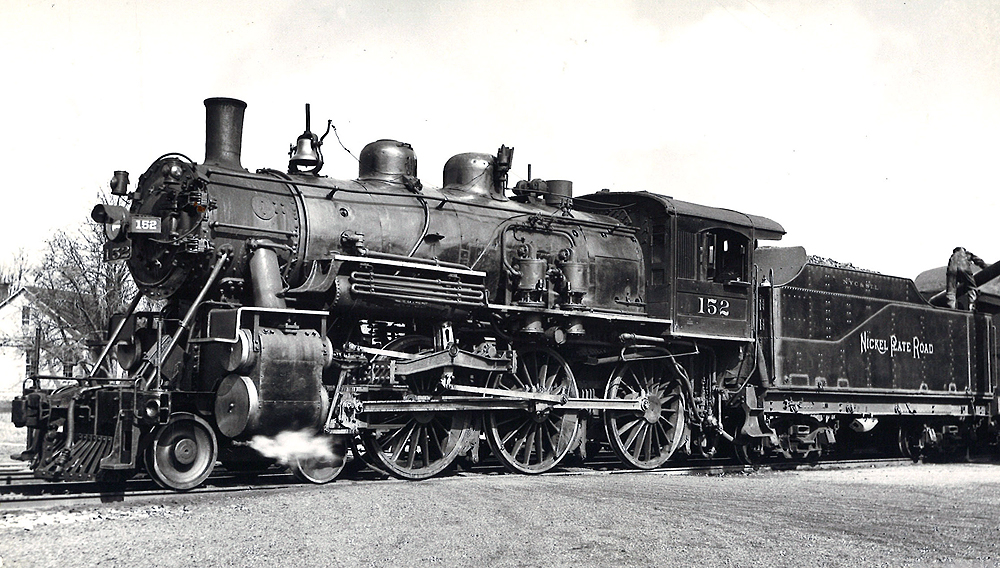
Baldwin Ten-Wheeler
The fireman of 4-6-0 steam locomotive No. 152 fills the tank with water during a stop with train 21 somewhere on the Sandusky Division on March 3, 1937. The Nickel Plate received six class R Ten-Wheelers from Baldwin in 1907; originally numbered 182 to 187, they became 150 to 155 in 1910.
Clyde E. Helms
The fireman of 4-6-0 steam locomotive No. 152 fills the tank with water during a stop with train 21 somewhere on the Sandusky Division on March 3, 1937. The Nickel Plate received six class R Ten-Wheelers from Baldwin in 1907; originally numbered 182 to 187, they became 150 to 155 in 1910.
Clyde E. Helms

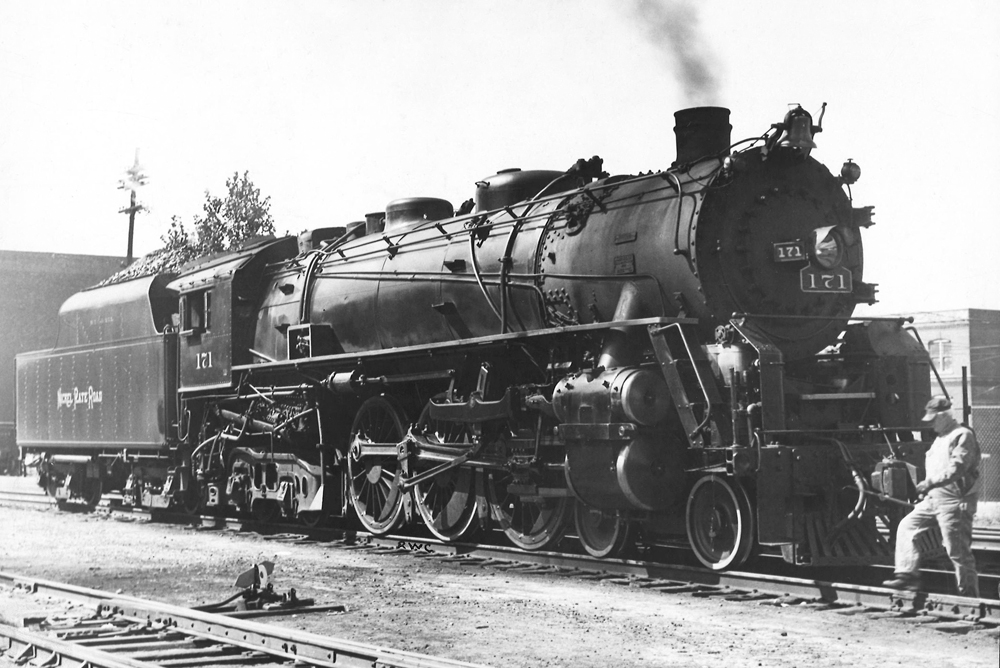
Lightweight Hudson
Nickel Plate’s eight 4-6-4s were among the lightest Hudson-type steam locomotives built for North American service. The first group, Nos. 170 to 173 (built by Alco’s Brooks works in 1927, just after New York Central’s first J-1 4-6-4s), had an engine weight of just 318,400 pounds. The later addition of smoke deflectors bulked up their appearance.
Roy W. Carlson
Nickel Plate’s eight 4-6-4s were among the lightest Hudson-type steam locomotives built for North American service. The first group, Nos. 170 to 173 (built by Alco’s Brooks works in 1927, just after New York Central’s first J-1 4-6-4s), had an engine weight of just 318,400 pounds. The later addition of smoke deflectors bulked up their appearance.
Roy W. Carlson

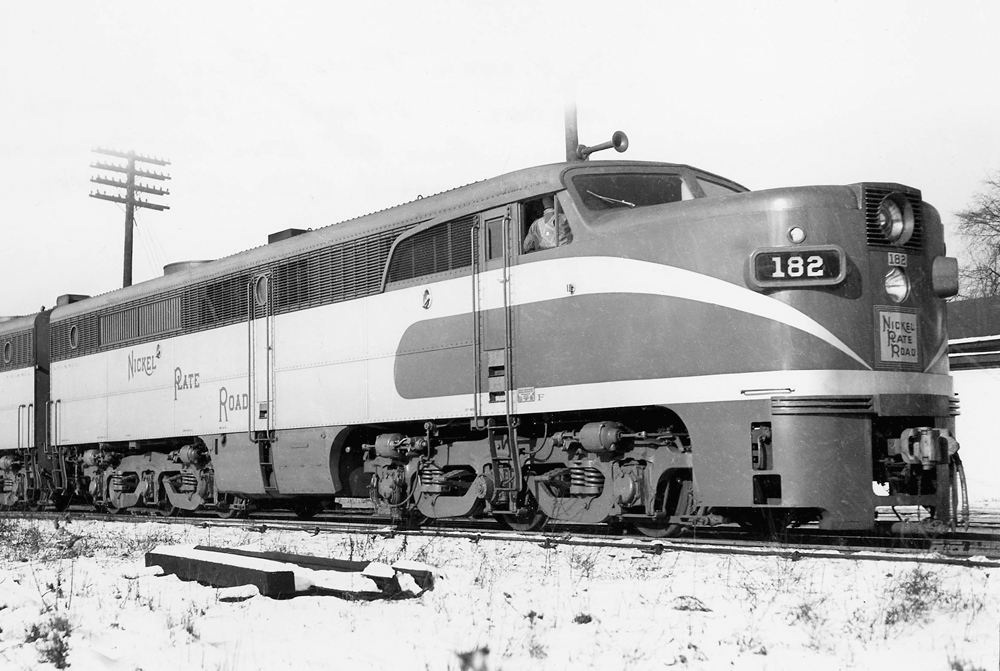
“Bluebird” PA
Nicknamed “Bluebirds” for their blue-and-silver paint scheme, Nickel Plate’s 11 Alco PA1 2,000-horsepower diesel locomotives were built between 1947 and 1948. They were numbered just above the Hudsons, which they replaced as top-rank passenger power. NKP No. 182, pictured at Conneaut, Ohio, on January 20, 1948, left Alco’s Schenectady plant in December 1947.
Paul W. Prescott
Nicknamed “Bluebirds” for their blue-and-silver paint scheme, Nickel Plate’s 11 Alco PA1 2,000-horsepower diesel locomotives were built between 1947 and 1948. They were numbered just above the Hudsons, which they replaced as top-rank passenger power. NKP No. 182, pictured at Conneaut, Ohio, on January 20, 1948, left Alco’s Schenectady plant in December 1947.
Paul W. Prescott

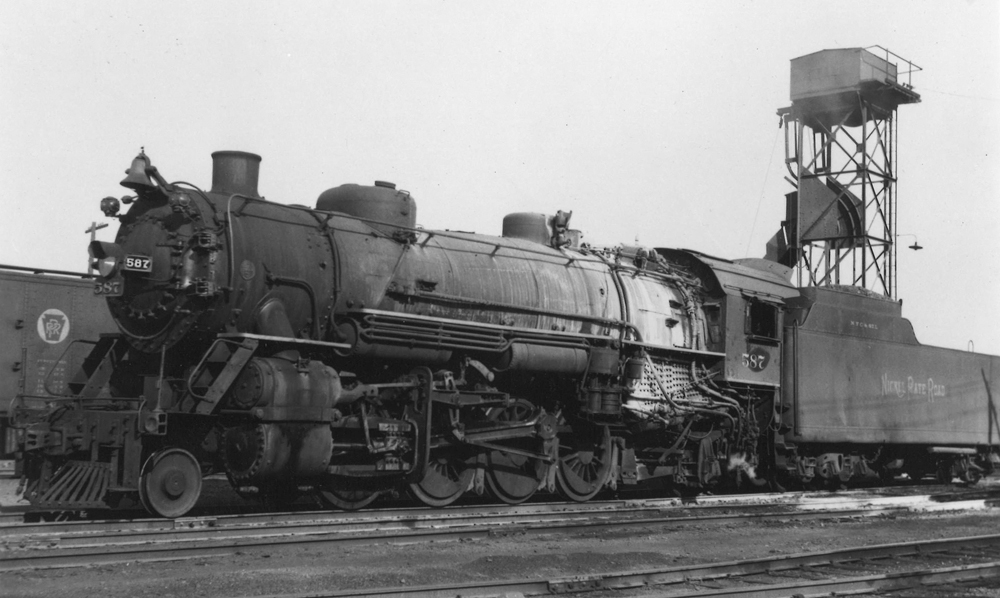
USRA Mikado
Nickel Plate’s 86 U.S. Railroad Administration-design light 2-8-2 steam locomotives were the road’s top freight power until the 2-8-4 Berkshires arrived. Nos. 601 to 671 were built for NKP by Alco (10 engines, in 1918) and Lima (61, 1920 to 1924), while Nos. 586 to 600 (Baldwin, 1918) arrived in 1923 when NKP acquired the Lake Erie & Western. Mikado No. 587, seen at Delphos, Ohio, in July 1946, was reactivated for excursion work by the Indiana Transportation Museum in 1988.
Jay Williams collection
Nickel Plate’s 86 U.S. Railroad Administration-design light 2-8-2 steam locomotives were the road’s top freight power until the 2-8-4 Berkshires arrived. Nos. 601 to 671 were built for NKP by Alco (10 engines, in 1918) and Lima (61, 1920 to 1924), while Nos. 586 to 600 (Baldwin, 1918) arrived in 1923 when NKP acquired the Lake Erie & Western. Mikado No. 587, seen at Delphos, Ohio, in July 1946, was reactivated for excursion work by the Indiana Transportation Museum in 1988.
Jay Williams collection

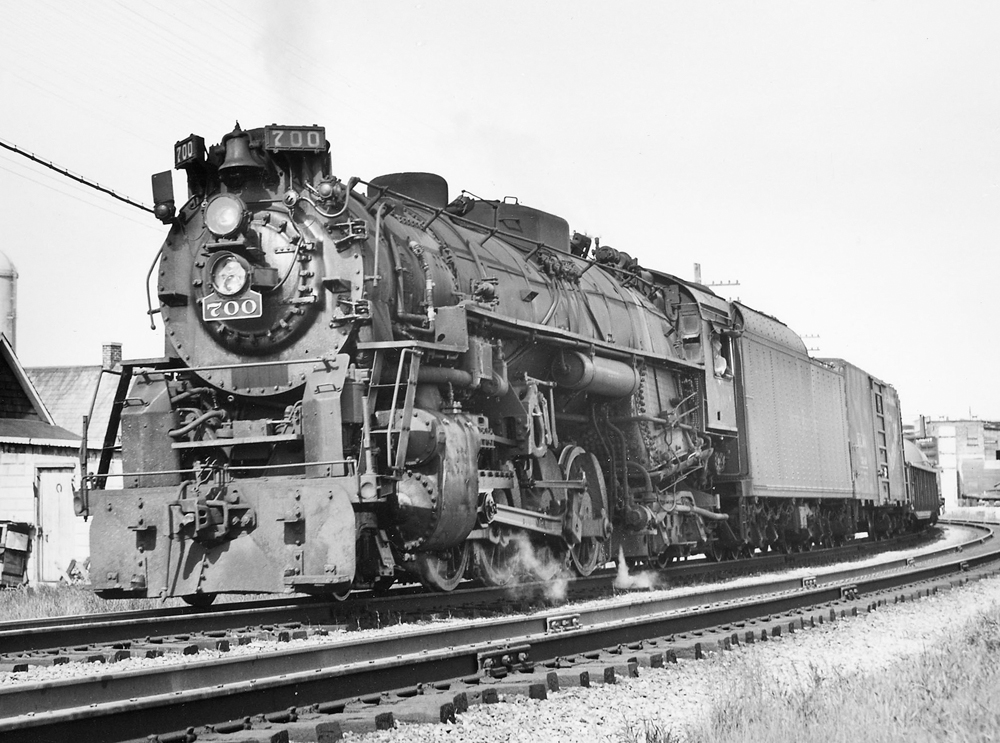
NKP’s first Berkshire
Nickel Plate Road No. 700, westbound at Fostoria, Ohio, in 1956, was the first of the line’s great fleet of 80 2-8-4 fast freight steam locomotives. Alco built the first 15, in 1934; Lima, whose super-power ideas informed the key aspects of the Berkshires’ design, supplied the rest, from 1942 to 1949. The sheet-metal pilot on No. 700 was a departure from the standard NKP bar type.
John A. Rehor
Nickel Plate Road No. 700, westbound at Fostoria, Ohio, in 1956, was the first of the line’s great fleet of 80 2-8-4 fast freight steam locomotives. Alco built the first 15, in 1934; Lima, whose super-power ideas informed the key aspects of the Berkshires’ design, supplied the rest, from 1942 to 1949. The sheet-metal pilot on No. 700 was a departure from the standard NKP bar type.
John A. Rehor

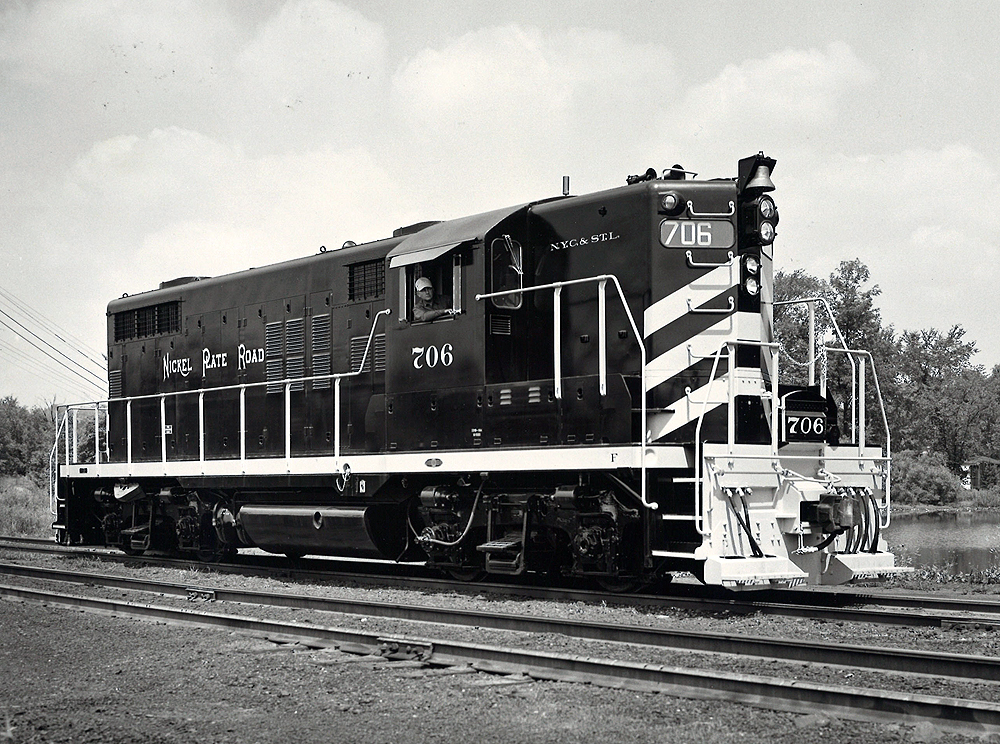
GP18 “usurper”
Nickel Plate’s Berkshires held off diesel locomotives into the 1950s, so the road had no freight cab units. NKP dieselized most of its road freights with EMD and Alco road-switchers. Between 1951 and 1959 the road acquired 48 GP7s and 106 GP9s, followed in 1960 by 10 GP18s. The 1,800-horsepower GP18s were numbered 700 to 709, a series recently vacated by the legendary 2-8-4s. They also came in a simplified paint scheme, with yellow stripes on the hood ends only.
Classic Trains collection
Nickel Plate’s Berkshires held off diesel locomotives into the 1950s, so the road had no freight cab units. NKP dieselized most of its road freights with EMD and Alco road-switchers. Between 1951 and 1959 the road acquired 48 GP7s and 106 GP9s, followed in 1960 by 10 GP18s. The 1,800-horsepower GP18s were numbered 700 to 709, a series recently vacated by the legendary 2-8-4s. They also came in a simplified paint scheme, with yellow stripes on the hood ends only.
Classic Trains collection

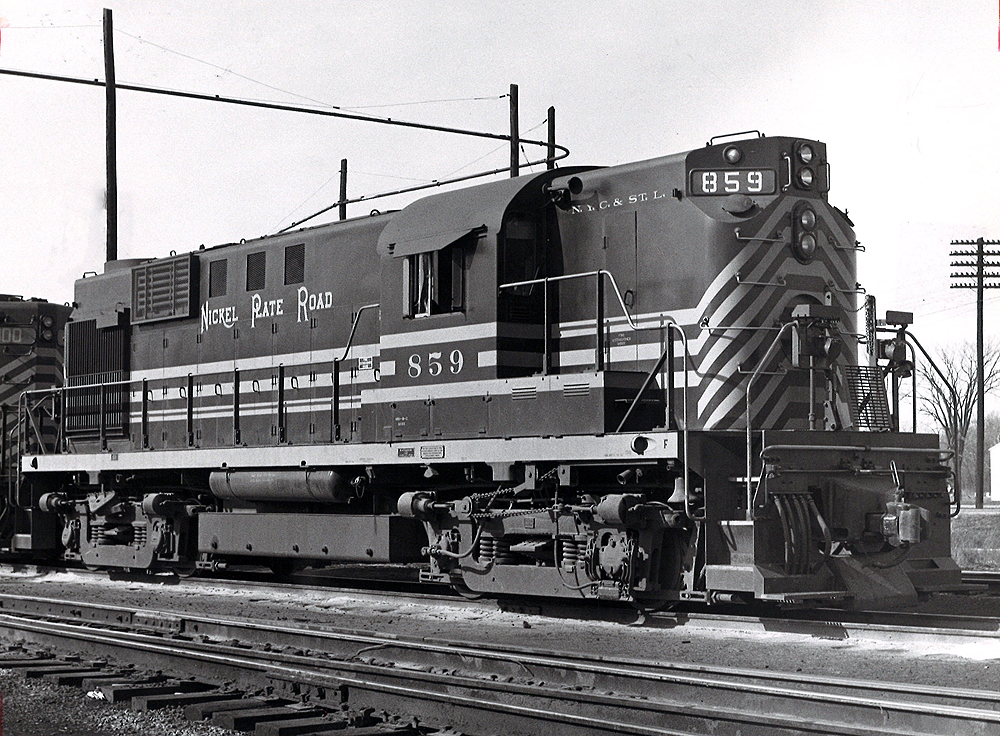
Alco’s improved road-switcher
Alco’s RS2 and RS3 road-switcher diesel locomotives were good sellers (including to NKP, which bought 23 RS3s), but their 244 engines left something to be desired. The improved 251 engine powered the 1,800-horsepower RS11 model, of which Nickel Plate bought 58 between 1956 and 1960.
Louis A. Marre
Alco’s RS2 and RS3 road-switcher diesel locomotives were good sellers (including to NKP, which bought 23 RS3s), but their 244 engines left something to be desired. The improved 251 engine powered the 1,800-horsepower RS11 model, of which Nickel Plate bought 58 between 1956 and 1960.
Louis A. Marre

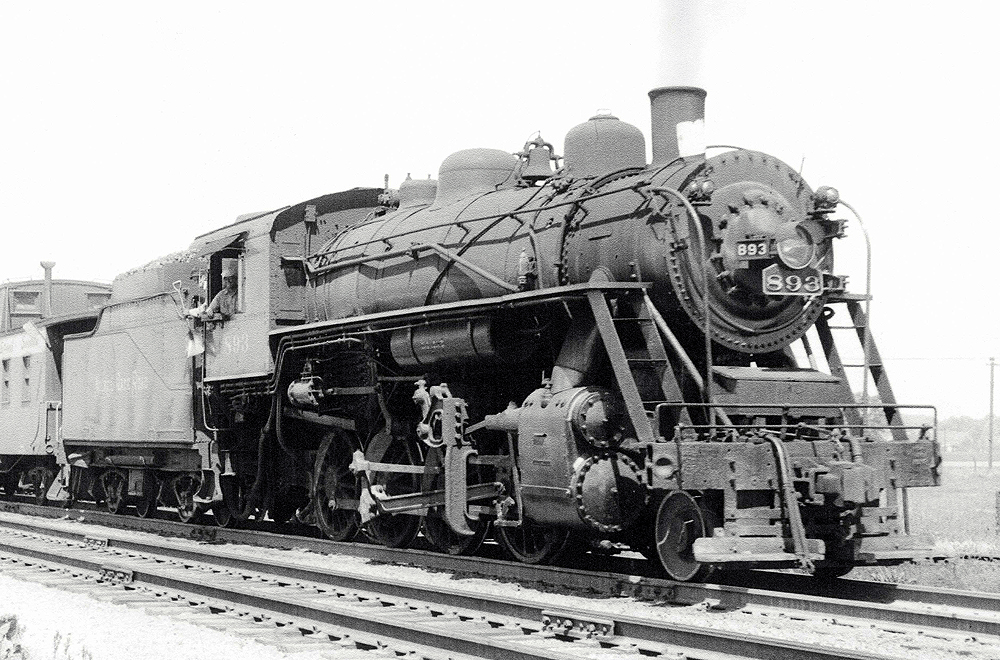
Heavy Consolidation
As on many roads, the 2-8-0 Consolidation-type steam locomotive was the Nickel Plate’s heavy freight power for the first decade-plus of the 20th century. Counting engines that came with the 1923 Lake Erie & Western and Toledo, St. Louis & Western acquisitions, NKP rostered more than 180 Consolidations. Engine 893, running backward as it helps an eastbound freight at Lafayette, Indiana, in the early 1950s, was built by Baldwin in 1913 for the TStL&W.
Hal Lewis
As on many roads, the 2-8-0 Consolidation-type steam locomotive was the Nickel Plate’s heavy freight power for the first decade-plus of the 20th century. Counting engines that came with the 1923 Lake Erie & Western and Toledo, St. Louis & Western acquisitions, NKP rostered more than 180 Consolidations. Engine 893, running backward as it helps an eastbound freight at Lafayette, Indiana, in the early 1950s, was built by Baldwin in 1913 for the TStL&W.
Hal Lewis

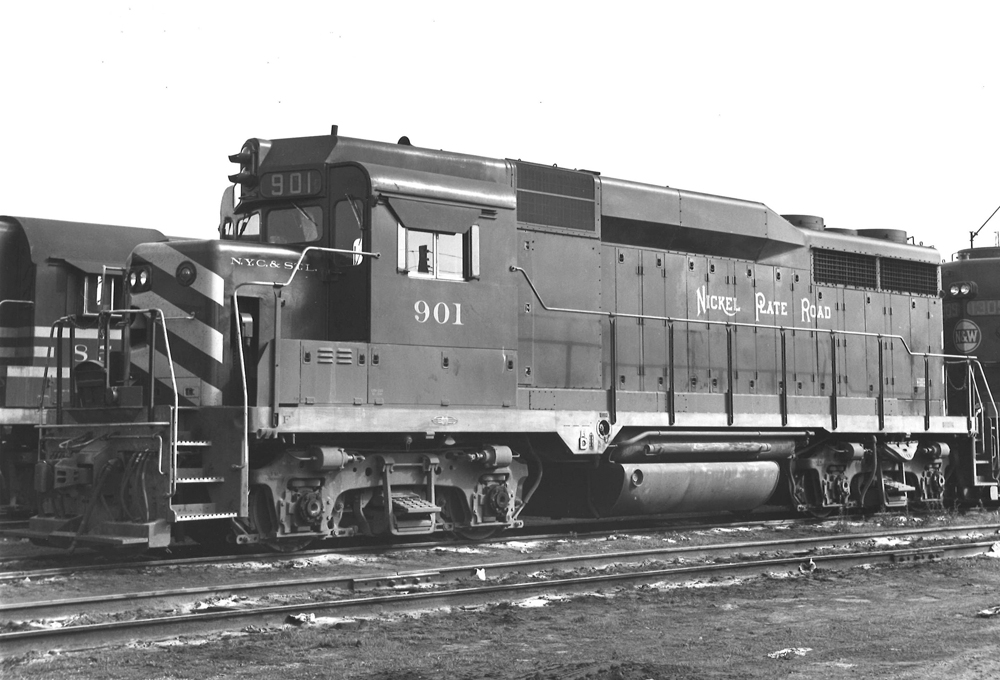
Stylish EMD road-switcher
Among Nickel Plate’s last diesel locomotive purchases was a group of 10 2,250-horsepower GP30s, received in 1962. The units carried their bells in a notch on the nose, and, typically for NKP diesels, lacked dynamic brakes. No. 901 stands at Bellevue, Ohio, on June 20, 1965 — eight months after NKP became part of the Norfolk & Western system.
Louis A. Marre
Among Nickel Plate’s last diesel locomotive purchases was a group of 10 2,250-horsepower GP30s, received in 1962. The units carried their bells in a notch on the nose, and, typically for NKP diesels, lacked dynamic brakes. No. 901 stands at Bellevue, Ohio, on June 20, 1965 — eight months after NKP became part of the Norfolk & Western system.
Louis A. Marre

Classic Trains editors are celebrating the heritage, history, and lore of famed (and infamous) railroads. In February 2020, we celebrate the New York, Chicago & St. Louis Railroad.
Please enjoy a collection of locomotive images located in the David P. Morgan Library archives at Kalmbach Media that include the Nickel Plate Road’s iconic locomotives and classic scenic photos.
You might also enjoy this NKP history article from Classic Trains, a photo gallery of Nickel Plate passenger trains, or freight trains.






